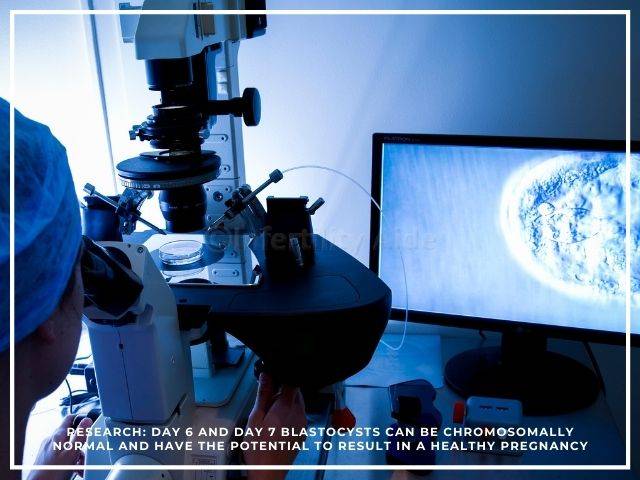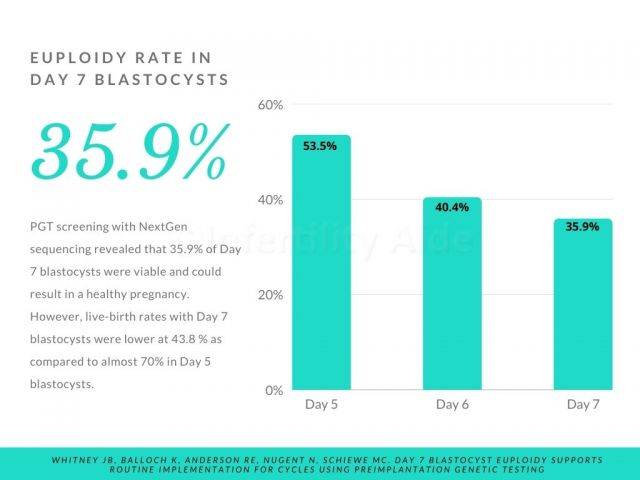Day 7 embryo transfers are less common since, by this point in a natural conception cycle, the embryo would have settled into the uterus.
The likelihood of a successful pregnancy is also influenced by the stage of embryo development at the time of transfer.
Considering the standard embryo grading in IVF, it is common practice to study the blastocysts on the fifth day of embryo culture and select the ones considered “good” for transfer.
Nonetheless, if embryologists are closely observing the growth of the embryos and feel that extending the culture to day 7 may increase the likelihood of choosing a suitable embryo for transfer, they may decide to do so in some instances.

Why is a day 7 embryo transfer done?
Transferring embryos on day seven is not very common and is usually only taken into consideration in certain circumstances where the embryos could benefit from longer culture. Here are several instances in which a day 7 embryo transfer could possibly be considered:
1. Delays in development: If the embryologist observes that the embryos are developing at a slower pace than anticipated, extending their time in culture might potentially increase the embryos’ likelihood of maturing into healthy blastocysts.
2. Increased risk of genetic abnormalities: If there is ever any doubt as to the genetic normalcy of the embryos, more time in culture could be necessary to do more testing and identify healthier embryos.
3. Limited number of viable embryos: If there are only a limited number of viable embryos available for transfer, the fertility team might choose to extend the culture to day 7 in the hope of selecting the most viable embryo.
4. Previous failed attempts: In order to increase the likelihood of success, the fertility experts may decide to use a day 7 transfer for a patient who has had many IVF setbacks.
5. Particular patient conditions: Sometimes a day 7 transfer is done in response to specific patient challenges, such as uterine conditions or susceptibility concerns.
Chances of success with day 7 blastocyst
In research conducted on more than 2,500 patients in Oxford, England(1), it was discovered that 43.1% of viable Day 7 embryos and 67.7% of viable Day 5 blastocysts were euploid.
The researchers observed that day 7 blastocysts had a somewhat decreased implantation rate as compared to the younger embryos.
According to another study involving 4500 women(2), blastocysts vitrified on day 7 were linked to a poor perinatal outcome in terms of a higher risk of very low gestational age (VLGA – 32 weeks) when compared to embryos at the day 3 cleavage stage.
However, blastocysts with various rates of growth were found to have comparable developmental survival, whether they were vitrified on day 5, day 6, or day 7.
Can day 7 blastocyst (PGT) be transferred?
Conventionally, embryos that did not form blastocysts by day 6 were considered unusable (3).
However, recent research has challenged this practice of ceasing embryo culture on day 6 as more studies confirm that embryos with blastulation upto day 7 can be viable, euploid (4) and totally result in healthy pregnancies and babies (5).

Dr. Colin Lee, who is one the top doctors for IVF in Malaysia, presented a study paper titled ‘Euploidy rate of Day 7 blastocysts derived from in-vitro fertilization’(6), at the 16th International Conference on Preimplantation Genetics 2017 in Valencia, Spain, demonstrating that 7 out of 15 embryos that were day 7 blastocysts (taken from 12 patients) were found viable after preimplantation genetic testing.
For patients who would not have any viable embryos if the culture ended on Day 6, extending the culture to Day 7 may effectively broaden the selection of transferable embryos. This is especially true for women who are older (over 35), since their embryos take slower to blastulate and are thus more vulnerable to cycle cancellation.
Success rates of day 7 embryos demonstrate that embryos achieving late blastulation can be totally viable and patients in certain circumstances may benefit from extending the culture.
References
- Tiegs, A. W., Sun, L., Patounakis, G., & Scott, R. T. (2019). Worth the wait? Day 7 blastocysts have lower euploidy rates but similar sustained implantation rates as Day 5 and Day 6 blastocysts. Human reproduction (Oxford, England), 34(9), 1632–1639. https://doi.org/10.1093/humrep/dez138
- Huang, J., Yang, X., Wu, J., Kuang, Y., & Wang, Y. (2020). Impact of Day 7 Blastocyst Transfer on Obstetric and Perinatal Outcome of Singletons Born After Vitrified-Warmed Embryo Transfer. Frontiers in physiology, 11, 74. https://doi.org/10.3389/fphys.2020.00074
- Y Shoukir, D Chardonnens, A Campana, P Bischof, D Sakkas, The rate of development and time of transfer play different roles in influencing the viability of human blastocysts., Human Reproduction, Volume 13, Issue 3, 1 March 1998, Pages 676–681, https://doi.org/10.1093/humrep/13.3.676
- Whitney, J. B., Balloch, K., Anderson, R. E., Nugent, N., & Schiewe, M. C. (2019). Day 7 blastocyst euploidy supports routine implementation for cycles using preimplantation genetic testing. JBRA assisted reproduction, 23(1), 45–50. https://doi.org/10.5935/1518-0557.20180089
- Du, T., Wang, Y., Fan, Y., Zhang, S., Yan, Z., Yu, W., Xi, Q., Chen, Q., Mol, B. W., Lyu, Q., & Kuang, Y. (2018). Fertility and neonatal outcomes of embryos achieving blastulation on Day 7: are they of clinical value?. Human reproduction (Oxford, England), 33(6), 1038–1051. https://doi.org/10.1093/humrep/dey092
- Yap, Wei Yuan et al. Euploidy rate of day 7 blastocysts derived from in vitro fertilization (IVF) Reproductive BioMedicine Online, Volume 36, e30 DOI: https://doi.org/10.1016/j.rbmo.2017.10.072
Reviewd by: Dr. Meenakshi, PhD